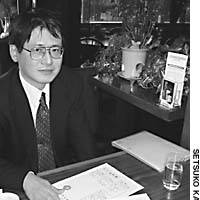Experts say it is possible for a Japanese person to trace his or her ancestors back about 300 years. Of course, it does require a long paper chase, but the government, which likes to keep tabs on its citizens, has done much of the work.
The obvious place to start is the koseki tohon (family registry). This contains information on family members of the same surname, including the way each individual entered the family (by birth, adoption or marriage), birth and death dates, and the names of the natural or adoptive parents.
Koseki tohon are filed in the local municipal office of the legal domicile of the first member listed on the registry.
When members of the household leave the registry due to death or marriage, their names are crossed out. When all the names have been removed, the defunct registry becomes a joseki tohon (removal registry) and is kept by the municipal office for 80 years. Joseki tohon that go back that far, plus the koseki tohon, should account for about five or more generations.
For Edo Period records, people search out family burial sites because, in Edo Japan, temples were the official channels of citizen registration.
In the mid-17th century the Tokugawa Shogunate, in an attempt to root out Christianity and other proscribed religious groups, implemented a system called terauke (temple guarantee) by which every Japanese was listed at birth as a parishioner of a bodaiji (family temple). The death of a parishioner was entered in a document known as the kakocho (death registry book), which also recorded their kaimyo (posthumous Buddhist name) and details of family relationships. Similar information was usually carved onto tombstones or inscribed on ihai (mortuary tablets), and this can be cross-referenced with the kakocho.
Given the information available, just how easy (or difficult) is it to construct a family tree? Ryoji Tanaka, 37, a math teacher from Saitama Prefecture has succeeded in tracing eight generations of his family, back to an ancestor who died in 1775. For the past eight years, he has also undertaken genealogical searches for other families.
Useful clues
For those like Tanaka, who still have connections with their family graves and temples, the procedure is fairly straightforward. But for those who have lost such links to the past it might be more complicated. Tanaka said the search should begin with tracking down the registered domicile of the oldest ancestor listed in the joseki. From there, he said, family names provide useful clues.
The Japanese commoners were officially granted the use of surnames in 1870 and more than 80 percent took their names from their place of residence. He recommends checking maps for places with the same family name.
Phone books are also a possible resource. If you find several households listed with the same surname, Tanaka said, it is a sign that the name has existed in that area for some time. These households may not necessarily be related, but chances are they shared the same family temple. Once the search has been narrowed to a particular area, local history can provide clues in related names or events.
A successful search can yield documentation from the early 18th or even the late 17th century. But in reality, Tanaka said, "not everyone has the good fortune to get that far back." Documents can be lost due to natural disasters or wars, for example. Also, the custom of establishing a family grave site didn't become widespread until the 18th century.
"I personally feel that making family trees isn't just about looking for your roots," Tanaka said.
"People should be happy with being able to figure out even just five generations back, and should also take pleasure in their family tree growing into the future."


















With your current subscription plan you can comment on stories. However, before writing your first comment, please create a display name in the Profile section of your subscriber account page.